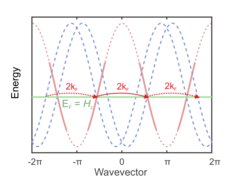The analogy between the behaviour of different quantum particles which have the same quantum nature is one of the most fascinating aspects of science. A simple but prominent example is the analogy between the behaviour of electrons (fermions) in a one-dimensional metal and spinons (fermions) in a one-dimensional quantum magnet. But, what are spinons?
It is generally known that magnetic fluctuations in conventional magnets can be seen as a wave of deflection of the magnetic moments out of the equilibrium. These waves are described by quantum mechanics as quasi-particles, known as magnons, which carry integer spin momentum S = 1 and therefore are bosons. However, in one-dimensional systems magnons decay (fractionalize) into two S = 1/2 spinon quasiparticles which are fermions. Their low-energy physics is described by the Tomonaga-Luttinger liquid of spinless fermions, similar to the conduction electrons in one-dimensional metals. Such Tomonaga-Luttinger liquid behavior has been observed in the quantum magnet YbAlO
3 (see press release:
Realization of a Tomonaga-Luttinger liquid in YbAlO3).
Recently, an international team of scientists from Germany (MPI CPfS Dresden), USA, China, Russia and Ukraine has studied YbAlO3 by means of magnetization and neutron diffraction experiments supported by numerical calculations and has shown that the weak interchain coupling produces Umklapp scattering between the left- and right-moving spinons. Under finite magnetic fields Hz this stabilizes an "unconventional" incommensurate spin-density wave order at the q = 2kF with kF being the Fermi wavevector. This mechanism is similar to Fermi surface nesting observed in metals. The Umklapp processes open a route to multiple coherent scattering of fermions, which results in the formation of satellites at integer multiples of the incommensurate fundamental wavevector Q = nq which were indeed measured by elastic neutron scattering. These results provide surprising and profound insight into band-structure control for emergent fermions in quantum materials and uncover a process of multiple fermion scattering in one-dimensional systems.

